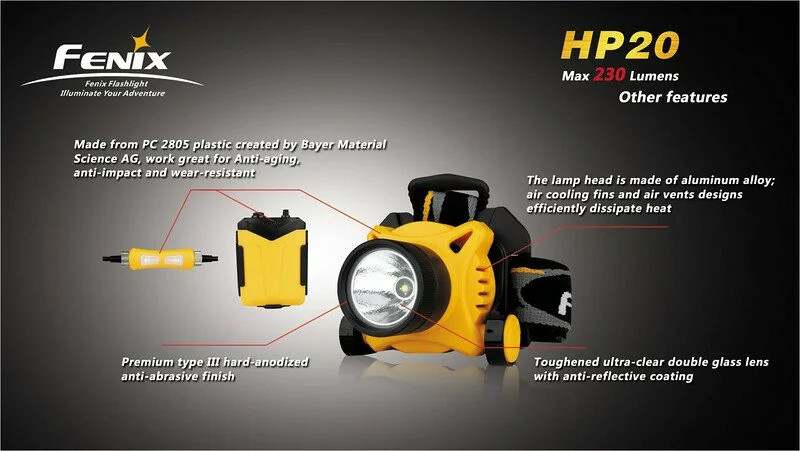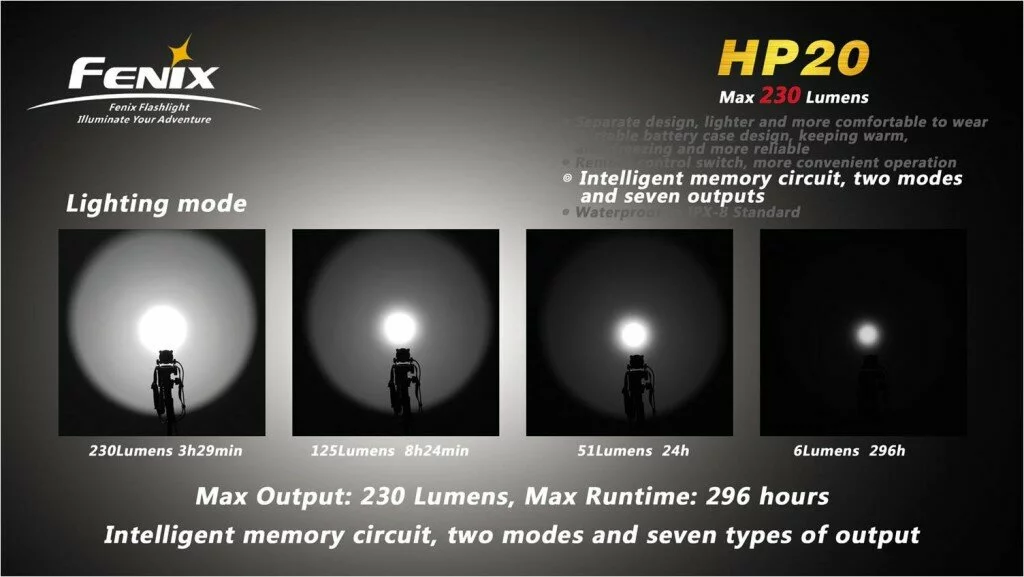
Editor rating
+ 9/10 All-around amzing gear
Pros
+ Extremely tough
+ Powerful output
+ Excellent runtime
Cons
– Company advertising claims
Introduction
Once again, a heartfelt thanks to Vitus for allowing me to test the HP20 for a short time. Vitus works for an oil pipeline company and his job, amongst lots of other things, involves going into the pipeline and identifying faults, whether potential or actual, and getting them repaired. In such a job, as you can imagine, a reliable and bright headlamp with a long runtime is of major importance.
The Fenix HP20 headlamp
The HP20 runs on four AA alkaline batteries or NiMH rechargeable batteries. The battery pack is far too heavy to carry on your head so the batteries are housed in a separate case which you can attach to your belt. The headlamp is connected to the batteries with a cable. The cable has an illuminated switch so you don’t need to reach up to your head or down to the battery case to fumble through the different modes.
Fenix claims that the HP20 ‘can effectively satisfy various high-intensity demands when cycling, searching and caving.’
Dimensions
The Fenix HP20 has the following dimensions:
Headlamp:
- Length: 7cm (2.75”)
- Width: 5.7cm (2.24”)
- Height: 5.6cm (2.20”)
- Weight (without batteries): 260g (9.17oz)
Battery Case:
- Length: 10.8cm (4.25”)
- Width: 7.9cm (3.11”)
- Height: 3cm (1.18”)
First Impressions
Everything about this lamp makes a rugged impression.The battery case is rock-solid and sealed with a thick o-ring. It is easy to open and close.
The headlamp also looks like it will stand the test of time. It is allegedly impact-resistant from a height of 1.5 metres. It is also submersible to a depth of 2 metres for more than 30 minutes, which, if true, makes it extremely waterproof.
Even the cable, the flimsiest part of the device, looks very durable. The switches on the cable look like a dimmer switch on a normal table lamp.

The operation was self-explanatory. You press the main switch on the battery case. This activates the cable switches. The yellow switch is for turning on and off. The blue switch is for turning on the different modes.
- The headlamp comes with a heavy-duty plastic box, similar to a small toolbox.
- There are two modes and seven different output levels. The headlamp memorises the last output used.
The HP20 outside
The lighting distance on max is advertised as 167 metres on the Fenix website. Do me a favour! This is a small headlamp, not a prison floodlight! As many torch companies make such wild claims, I tried to approach this aspect of the headlamp with an open mind.
I tested the output in some nearby fields under light snowfall and was very impressed. The HP20 is easily good for 80 metres on maximum. This is exceptional performance when you consider the size of the lamp and the battery configuration. The lamp has a good combination of spill and spot beam and illuminated much wider than I expected it to.
The battery case can be attached to your belt or trouser pocket, or even stowed inside your rucksack or inside jacket pocket. I found mounting it on my belt the best variation. It is comfortable to wear and stays in place. After turning on the main switch, you won’t need to use it again. This is good, because in caves or mines you will probably be wearing it under a jacket.
The cable switches are a revelation. The yellow and blue switches are illuminated and ingeniously simple to use. Furthermore, I had no problems whatsoever flicking through the different modes wearing very thick gloves.
Output
The HP20 has the following advertised output and runtimes:
- Turbo: 230 lumens, 3 hours 29 minutes
- High: 125 lumens, 8 hours 24 minutes
- Mid: 51 lumens, 24 hours
- Low: 6 lumens, 296 hours
- Strobe: 230 lumens
- Slow flash: 51 lumens
- SOS: 51 lumens
I find these outputs to be well spaced out, both in theory and practice.

I only tested the turbo runtime. For this test I used rechargeable 2700mAh batteries. The light becomes very hot just after 75 minutes. In fact, you cannot touch it for more than a few seconds as it will burn your fingers. Fortunately, you can still wear it on your head, as the headband fully protects your forehead. It feels slightly warm, but it is not uncomfortable.
After 90 minutes I took the lamp outside to see what it was still capable of doing. I went back to the same fields (no snow this time) and was rather surprised to see that it still easily lit up to 60 metres away.
After 3 hours the lamp was still incredibly bright, completely flooding my small back garden, but shortly after became noticeably dimmer until it died after 3 hours and 40 minutes.
Some Issues
I checked the headlamp on the Fenix website. The excellent graphics and the features, listed in easy-to-understand bullet points, are very impressive. But let’s ignore the gloss and focus on the facts.
The company mentions the word ‘freezing’ or ‘anti-freezing’ eight times in its presentation of the HP20. Of course, with such overkill, some gullible souls may already be planning their Christmas holiday in Alaska. Unfortunately, there is no indication anywhere of the minimum temperature under which the torch will operate. This is an unforgivable omission in my view.
In addition, the website and the manual extol the HP20 as a useful light when cycling. This is downright nonsense.
First of all, why clutter your body with headlamp, cable and battery pack? Surely it’s much simpler (and cheaper) to fix a decent bike light or torch to your handlebars.
Secondly, this is certainly not the kind of lamp you can simply stash in your jacket after dismounting, as it is both heavy and bulky. To give you an idea of what I mean, the box provided to transport the torch measures 19cm x 13.5cm. (see photo)

More importantly, when switching on or off or changing modes, you automatically look down towards your waist while fumbling for the switch. This is not only annoying, but also very dangerous.
I tried cycling with the HP20 twice in complete darkness. Believe me, this is no bike light.
Conclusion
Despite the claims of the manufacturer, I gave the Fenix HP20 a very good rating because it is a very good lamp for the speciality user.
For those, like Vitus, working in confined spaces (potholers, cavers, miners), or even people working in the search and rescue sector, this headlamp could be the ideal companion.
The beam has a good mixture of flood and throw, so it is not just ideal for narrow passages, but also wide open spaces. The runtime is outstanding. The switch mechanism is absolutely fool-proof. In addition, the light also contains the functions (SOS, slow blinking) required in an emergency situation. The HP20 is tough, durable, waterproof and runs on readily-available household batteries. What is there not to like?
I was going to downgrade the rating of the lamp because of the misleading marketing of this product, but in the end I decided against it. After all, it is not the lamp’s fault if its producer is economical with the truth.
See more in this Category
- Spark Headlamp ST6-360CW
- Fenix HL21 Headlamp
- Fenix HP20 Headlamp
- ITP H01 Headlamp